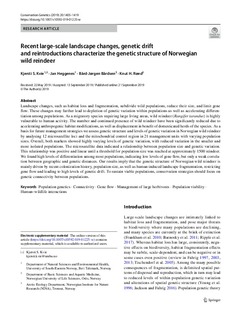| dc.contributor.author | Kvie, Kjersti | |
| dc.contributor.author | Heggenes, Jan | |
| dc.contributor.author | Bårdsen, Bård-Jørgen | |
| dc.contributor.author | Røed, Knut | |
| dc.date.accessioned | 2019-11-08T07:41:29Z | |
| dc.date.available | 2019-11-08T07:41:29Z | |
| dc.date.created | 2019-10-30T11:05:07Z | |
| dc.date.issued | 2019 | |
| dc.identifier.citation | Conservation Genetics. 2019, 20 1405-1419. | nb_NO |
| dc.identifier.issn | 1566-0621 | |
| dc.identifier.uri | http://hdl.handle.net/11250/2627273 | |
| dc.description.abstract | Landscape changes, such as habitat loss and fragmentation, subdivide wild populations, reduce their size, and limit gene flow. These changes may further lead to depletion of genetic variation within populations as well as accelerating differentiation among populations. As a migratory species requiring large living areas, wild reindeer (Rangifer tarandus) is highly vulnerable to human activity. The number and continued presence of wild reindeer have been significantly reduced due to accelerating anthropogenic habitat modifications, as well as displacement in benefit of domesticated herds of the species. As a basis for future management strategies we assess genetic structure and levels of genetic variation in Norwegian wild reindeer by analysing 12 microsatellite loci and the mitochondrial control region in 21 management units with varying population sizes. Overall, both markers showed highly varying levels of genetic variation, with reduced variation in the smaller and more isolated populations. The microsatellite data indicated a relationship between population size and genetic variation. This relationship was positive and linear until a threshold for population size was reached at approximately 1500 reindeer. We found high levels of differentiation among most populations, indicating low levels of gene flow, but only a weak correlation between geographic and genetic distances. Our results imply that the genetic structure of Norwegian wild reindeer is mainly driven by recent colonization history, population size, as well as human-induced landscape fragmentation, restricting gene flow and leading to high levels of genetic drift. To sustain viable populations, conservation strategies should focus on genetic connectivity between populations. | nb_NO |
| dc.language.iso | eng | nb_NO |
| dc.rights | Attribution-NonCommercial-NoDerivatives 4.0 Internasjonal | * |
| dc.rights.uri | http://creativecommons.org/licenses/by-nc-nd/4.0/deed.no | * |
| dc.title | Recent large‑scale landscape changes, genetic drift and reintroductions characterize the genetic structure of Norwegian wild reindeer | nb_NO |
| dc.type | Journal article | nb_NO |
| dc.type | Peer reviewed | nb_NO |
| dc.description.version | publishedVersion | nb_NO |
| dc.source.pagenumber | 1405-1419 | nb_NO |
| dc.source.volume | 20 | nb_NO |
| dc.source.journal | Conservation Genetics | nb_NO |
| dc.identifier.doi | 10.1007/s10592-019-01225-w | |
| dc.identifier.cristin | 1742102 | |
| dc.relation.project | Nordforsk: “Nordic Centre of Excellence” | nb_NO |
| dc.relation.project | Andre: University College of Southeast Norway, Bø in Telemark | nb_NO |
| dc.relation.project | Andre: Norwegian Wild Reindeer Centre | nb_NO |
| cristin.unitcode | 192,16,1,0 | |
| cristin.unitname | Institutt for basalfag og akvamedisin | |
| cristin.ispublished | true | |
| cristin.fulltext | original | |
| cristin.qualitycode | 1 | |

